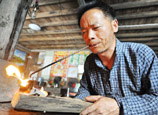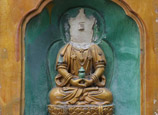
Banpo Museum
Located to the north of Banpo village in the east suburb of Xi’an city, Banpo Museum is a key cultural heritage site under state protection. It exhibits the typical matriarchal society of the Neolithic Age in the Yellow River valley. The remains of houses, cellars, pottery-making kilns, separate burials of men and women, production tools and utensils found in the site vividly show the livelihood of early settlers in the matriarchal society about 6,000 years ago. The museum is of great scientific significance to the study of primitive society in China.
Cangjie Temple
Cangjie Temple is a key cultural heritage site under state protection and a national AAA-level attraction. The temple is located in the Shiguan Village 35 kilometers northeast of Baishui County, Weinan city, Shaanxi. Bordered to the north by Mount Huanglong and to the south by the Luohe River, Cangjie Temple is the only one in existence to commemorate Cangjie— creator of written Chinese character. Luxuriant cypresses inside and fertile land around setting off each other offer a marvelous view!
Mausoleum of Yellow Emperor
The Mausoleum of Yellow Emperor is a key cultural heritage site under state protection and a national AAAAA-level tourist attraction which is located on Mount Qiaoshan to the north of Huangling County Shaanxi Province. The tomb is dedicated to the Yellow Emperor who was believed to be the founder of Chinese nation. Known as “the First Tomb under Heaven,” it was the place where emperors and celebrities of different dynasties held worshipping ceremonies in memory of the Yellow Emperor. Since its construction in the Tang Dynasty around AD 770, the temple has been the altar for emperors in different dynasties to hold the Grand National Sacrificial Ceremonies. Nowadays, on every Qingming Festival in early April, Chinese descendants, regardless of places of birth, would come here to venerate the Yellow Emperor.
Mausoleum of Yandi Emperor
Located in Mount Changyang in Shenlong town, Weibin district in Baoji city, the imperial palace of Yandi Emperor imitated the architectural style of the Ming and Qing dynasties. Carved beams and painted rafters make the palace majestic while the luxuriant cypresses and pines create a stately and solemn atmosphere to the mausoleum. For thousands of years, numerous veneration ceremonies have been performed annually around here. Officials, businessmen, poets and scholars recall the past and write articles and poems here from generation to generation, leaving their eternal recollection to Yandi Emperor and his mausoleum behind.
















 Man commits suicide, rescued by his wife in NE China
Man commits suicide, rescued by his wife in NE China


![]()
